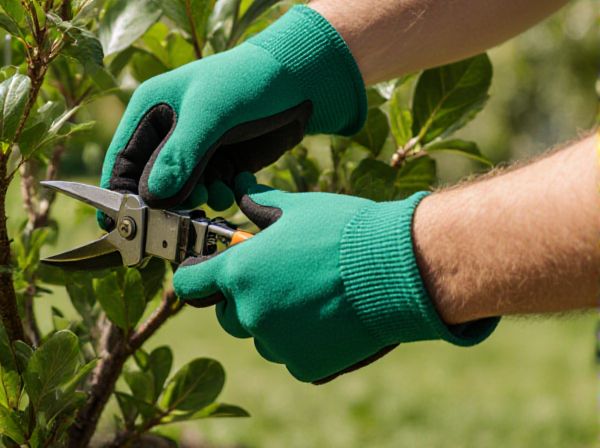
Topiary Pruning vs Espalier Pruning Illustration
Topiary pruning sculpts shrubs and trees into intricate shapes, enhancing garden aesthetics through artistic design, while espalier pruning trains plants to grow flat against a support, maximizing space and improving fruit production. Both techniques require precise cuts and consistent maintenance to ensure the desired form and healthy growth. Choosing between topiary and espalier pruning depends on whether the focus is ornamental creativity or functional space optimization.
Table of Comparison
| Aspect | Topiary Pruning | Espalier Pruning |
|---|---|---|
| Definition | Shaping plants into ornate, geometric, or natural forms. | Training plants to grow flat against a structure, like a wall or trellis. |
| Purpose | Decorative, aesthetic garden art. | Space-saving, maximizing sunlight exposure, and fruit production. |
| Typical Plants | Boxwood, yew, holly, privet. | Fruit trees like apple, pear, citrus, and some ornamental species. |
| Pruning Technique | Frequent, detailed trimming to maintain shapes. | Selective pruning to encourage flat branching and structure adherence. |
| Growth Direction | Three-dimensional shapes. | Two-dimensional, flat against a support. |
| Maintenance Level | High; requires consistent shaping and trimming. | Moderate; periodic pruning to maintain form and productivity. |
| Space Utilization | Requires ample space for three-dimensional forms. | Optimizes narrow or limited garden spaces. |
| Visual Impact | Bold, sculptural, artistic presence. | Elegant, structured, and architectural appearance. |
Introduction to Topiary and Espalier Pruning
Topiary pruning shapes shrubs and trees into ornamental forms, enhancing garden aesthetics with geometric or whimsical designs. Espalier pruning trains plants to grow flat against surfaces like walls or fences, maximizing space and improving fruit production. Both techniques require precise cuts and regular maintenance to maintain desired shapes and promote healthy growth.
Defining Topiary Pruning: Artistry in the Garden
Topiary pruning transforms shrubs and trees into intricate shapes, combining horticultural skill with artistic expression to enhance garden aesthetics. This technique requires precise cutting and shaping to create geometric forms or whimsical designs, making it a living sculpture in outdoor spaces. Mastery of topiary pruning demands knowledge of plant growth patterns and patience to maintain the desired form over time.
Exploring Espalier Pruning: Function Meets Aesthetics
Espalier pruning transforms trees into flat, decorative forms trained against walls or fences, optimizing space and enhancing garden aesthetics. Functionally, this technique improves sunlight exposure and air circulation, promoting healthier fruit production and easier maintenance. The precise, artistic shaping of espalier pruning merges horticultural efficiency with striking visual appeal, distinguishing it from more sculptural topiary methods.
Key Techniques in Topiary Pruning
Topiary pruning involves carefully sculpting plants into defined shapes using precise clipping and trimming techniques to maintain structural form and density. Key techniques include regular shearing to encourage dense foliage growth, selective thinning to enhance airflow and light penetration, and using wire frames as guides for complex geometric designs. Skilled topiary artists focus on maintaining balance and symmetry, ensuring the plant's health while achieving the desired ornamental shape.
Essential Methods for Espalier Pruning
Espalier pruning requires precise horizontal training and regular thinning cuts to maintain the desired two-dimensional growth pattern along a support structure. Essential methods include carefully selecting main scaffold branches, removing vertical shoots to encourage lateral growth, and timing cuts during dormancy for optimal healing and shape retention. This technique maximizes sunlight exposure and air circulation, promoting healthy fruit production and ornamental appeal.
Plant Selection: Best Species for Topiary vs Espalier
Topiary pruning thrives with dense, evergreen species such as boxwood (Buxus sempervirens), yew (Taxus baccata), and holly (Ilex crenata) due to their small leaves and tolerance for precise shaping. Espalier pruning favors fruit-bearing trees like apple (Malus domestica) and pear (Pyrus communis), as well as ornamental plants like quince (Cydonia oblonga), which respond well to training against flat surfaces. Selecting the right species ensures optimal growth patterns and maintenance ease for each pruning style.
Tools Required for Topiary and Espalier Pruning
Topiary pruning typically requires specialized hand shears, hedge trimmers, and sometimes electric pruners to shape shrubs into precise forms, emphasizing accuracy and control. Espalier pruning demands a combination of sharp bypass pruners, loppers for thicker branches, and tying materials like garden wire or clips to train branches along support structures. Both techniques benefit from protective gloves and pruning saws, but their toolkits differ mainly in the need for structural training aids in espalier pruning.
Benefits and Challenges of Topiary Pruning
Topiary pruning enhances garden aesthetics by shaping shrubs into precise, artistic forms, providing visual interest and structure to landscapes. This technique requires regular maintenance and expert skill to achieve sharp, clean lines, making it labor-intensive and time-consuming. Despite these challenges, topiary pruning supports healthy plant growth through careful trimming that encourages dense foliage and air circulation.
Advantages and Considerations of Espalier Pruning
Espalier pruning offers space-saving benefits by training plants to grow flat against walls or fences, enhancing sunlight exposure and air circulation. This method improves fruit yield and quality in fruit trees by allowing better access for maintenance and harvesting. Considerations include the need for regular training and maintenance to maintain the desired shape and structural support to guide the growth effectively.
Choosing the Right Pruning Style for Your Garden
Topiary pruning shapes plants into decorative forms, enhancing focal points with artistic precision, ideal for formal gardens and structured designs. Espalier pruning trains trees against flat surfaces, optimizing space and improving fruit production, perfect for small gardens or walls. Selecting the right style depends on garden layout, desired aesthetic, and plant type, ensuring both beauty and functionality in your outdoor space.
Topiary Pruning vs Espalier Pruning Infographic

 gardendif.com
gardendif.com